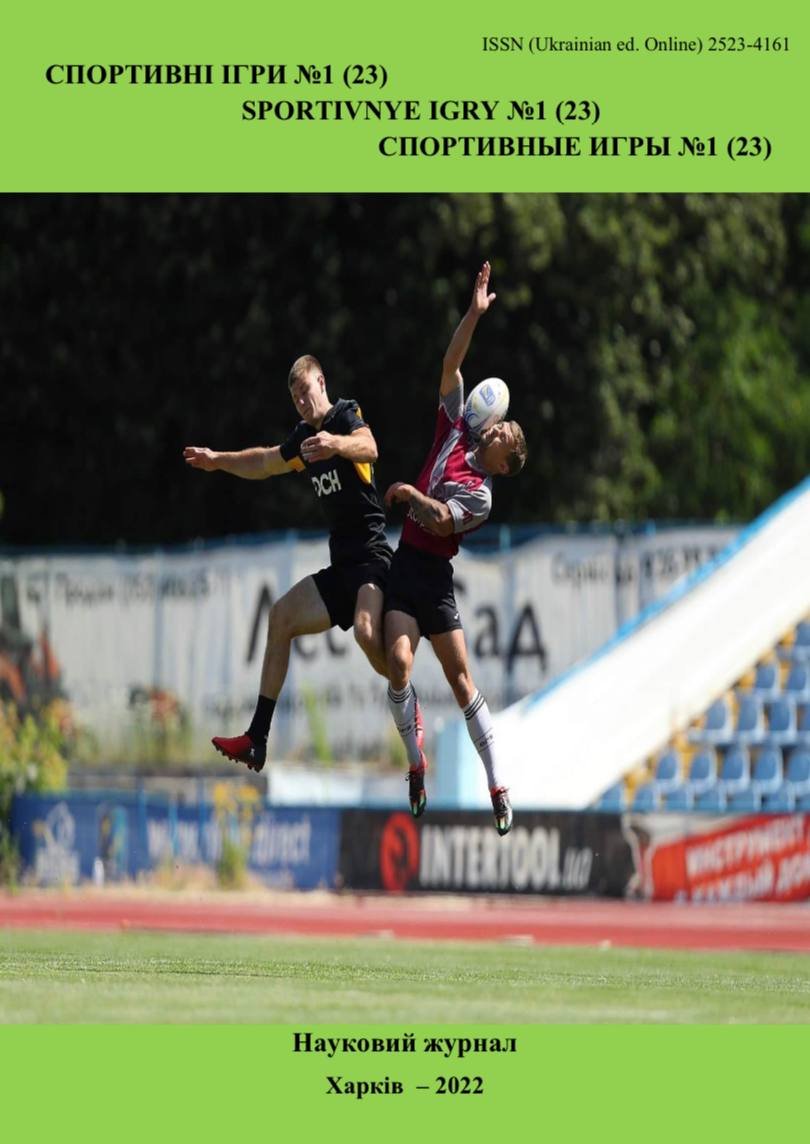Changing the level of physical preparedness of ten-year-old tennis players under the influence of GPhT classes
DOI:
https://doi.org/10.15391/si.2022-1.08Keywords:
physical preparedness, tennis, physical exercise, general physical trainingAbstract
The article is devoted to the
general physical preparedness of young tennis players, which is an integral part of the sportsmen
preparation. The purpose of the study is to determine changes in the level of physical fitness of ten-year-old tennis players under the influence of GPhT classes. The aim of the research is to reveal the
level of physical preparedness of ten-years-old tennis players 8 young 10 years old tennis players (4
girls and 4 boys), who train in the sport club "Sport & court" in Kharkiv. took part in the research.
The following methods were used in the study: analysis and generalization of literary sources,
testing, pedagogical experiment and methods of mathematical statistics. The results of the initial
testing show that the indicators of the stuied boys’ physical qualities is slightly higher than girls’
physical qualities, although no significant differences were found between them (p≥0.05). The
comparison of the results obtained during the study with the standards for ten-year-old students
showed that the results in all tests, except for leaning forward from a sitting position, correspond
to scores of 4 and 5. Flexibility indicators for girls correspond to a score of 2, for boys - 1 point.
For four months, young tennis players were taught twice a week on GPhT, which used exercises
aimed at improving speed, speed-strength, coordination and strength abilities, endurance and
flexibility. Analysis of the results obtained in retesting shows that the results of girls in almost all
tests are higher than in boys. Only the dexterity scores of 4×9 m and the strength of the abdominal
muscles, which were determined by lifting the torso to the buttocks from a supine position, were
higher in boys. It should be noted that the reliability between the indicators of physical qualities
in girls and boys was not observed (p≥0.05). There were no significant changes between the
indicators at the beginning and end of the study (p≥0.05), which, in our opinion, is due to the short
duration of the study and the large variance in the results of athletes. The biggest changes were
in the indicators of flexibility, which increased by 27.4% for girls, 21.3% for boys, and 24.2% for
girls in the "snake" race, and 18.4% for boys.
References
Боллетьери, Н. (2003) Теннисная Академия. М. : Эксмо
Верхошанский, Ю.В. (1988) Основы специальной физической подготовки спортсменов. М. : Физическая культура и спорт.
Иванова, Т.С. (2000) Основы подготовки юных теннисистов. М. : «Принт Центр»
Крилов, Д.С. & Шестерова, Л. Є. (2018). Дослідження особливостей виконання удару справа з відскоку десятирічними тенісистами в високому ігровому темпі. Науковий часопис національного педагогічного університету імені М. П. Драгоманова. «Науковопедагогічні проблеми фізичної культури / фізична культура і спорт», 1 (95)18, 80-83.
Кудря, О.Н., Филимонова, Е.В. (2015) Развитие специальной выносливости теннисистов 12-14 лет с учетом смены покрытия кортов. Омский научный вестник серия «Общество. История. Современность», 1 (135), 143-146.
Лелеко Д.А., Камаев, О.И. (2014) Физическая подготовленность теннисистов на этапе специализированной базовой подготовки. Физическое воспитание и спорт в высших учебных заведениях : сб. науч. труд. Ч.2, 128-134.
Тополь, А.И. (2001). Сопряженная методика тренировки, направленная на воспитание скоростно-силовых и двигательно-координационных качеств юных спортсменов 12-13 лет в игровых видах спорта (на примере тенниса). (Автореф. дис. канд. пед. наук)
Москва, Россия
Скородумова, А.П. & Тарпищев, Ш.А. (2011). Теннис: учебник для вузов физ. культуры. Москва : Азбука.
Усатова, Е.В. (2016). Развитие специальной выносливости теннисистов 13-14 лет при подготовке к игре на кортах с медленным покрытием. (Автореф. дис. канд. пед. наук) Омск, Россия
Шестерова, Л.Е., Пятницкая, Д. В., & Грищенко, Л. К. (2021) Состояние физической подготовленности десятилетних теннисистов. Спортивні ігри, 1(19), 95-100. doi: 10.15391/si.2021-1.10
Galé-Ansodi C., Castellano J. & Usabiaga O. (2017). More acceleration and less speed to assess physical demands in female young tennis players. International Journal of Performance Analysis in Sport, 17, 872-884. DOI: 10.1080/24748668.2017.1406780
Gescheit, D. T., Cormack, S. J., Reid, M. [et al.] (2015). Consecutive days of prolonged tennis match play: performance, physical, and perceptual responses in trained players. International journal of sports physiology and performance, 10 (7), 913-920.
Krylov, D. & Shesterova, L. (2017). Application of the "Play and Stay" program in the training of tennis players up to 10 years. Slobozhanskyi herald of science and sport, 6(62), 48-50.
Munivrana, G., Filipčić ,A. & Filipčić, T. (2015). Relationship of speed, agility, neuromuscular power, and selected anthropometrical variables and performance results of male and female junior tennis players. Collegium antropologicum, 39(1), 109-116.
Olcucu, B., & Vatansever, S. (2015). Some physical fitness parameter test results among 7-8 years old tennis players. International Journal of Academic Research, 7, 196-201. Winnick, J. & Porretta, D. (2016). Adapted Physical Education and Sport, 6E, Human Kinetics. 101.
Xiaowen, L. (2017) Discussion on the Method and the Importance of Physical Fitness Training in Tennis. Executive Chairman, 97-102.













